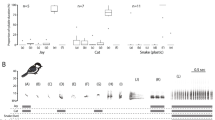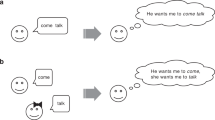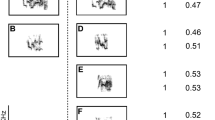Abstract
To evaluate the flexibility in vocal production and comprehension in a non-human primate, we presented a drone to West African green monkeys, Chlorocebus sabaeus. Calls given in response to the drone were clearly distinct from those given to other predators, but highly similar to the aerial alarm calls of the East African vervet monkey, Chlorocebus pygerythrus, suggesting that call structure is conserved. To probe how rapidly the animals attached meaning to the sound of the drone, we played back the drone sound after one to three exposures. Subjects immediately scanned the sky and ran for cover. In contrast to vocal production, comprehension learning was rapid and open-ended.
This is a preview of subscription content, access via your institution
Access options
Access Nature and 54 other Nature Portfolio journals
Get Nature+, our best-value online-access subscription
$29.99 / 30 days
cancel any time
Subscribe to this journal
Receive 12 digital issues and online access to articles
$119.00 per year
only $9.92 per issue
Buy this article
- Purchase on Springer Link
- Instant access to full article PDF
Prices may be subject to local taxes which are calculated during checkout


Similar content being viewed by others
Data availability
Data are available at https://doi.org/10.17605/OSF.IO/F4UTP.
Code availability
Code is available at https://doi.org/10.17605/OSF.IO/F4UTP.
References
Fischer, J. Psychon. Bull. Rev. 24, 72–78 (2017).
Fitch, W. T. The Evolution of Language (Cambridge University Press, 2010).
Zuberbühler, K. Adv. Study Behav. 33, 265–307 (2003).
Townsend, S. W. & Manser, M. B. Ethology 119, 1–11 (2013).
Manser, M. B. Proc. R. Soc. B 268, 2315–2324 (2001).
Gill, S. A. & Bierema, A. M.-K. Ethology 119, 449–461 (2013).
Arnold, K. & Zuberbühler, K. Curr. Biol. 18, 202–203 (2008).
Schamberg, I., Cheney, D. L., Clay, Z., Hohmann, G. & Seyfarth, R. M. Anim. Behav. 122, 109–116 (2016).
Coye, C., Ouattara, K., Arlet, M. E., Lemasson, A. & Zuberbühler, K. Anim. Behav. 141, 171–181 (2018).
ten Cate, C. Psychon. Bull. Rev. https://doi.org/10.3758/s13423-016-1091-9 (2016).
Seyfarth, R. M., Cheney, D. L. & Marler, P. Anim. Behav. 28, 1070–1094 (1980).
Seyfarth, R. M., Cheney, D. L. & Marler, P. Science 210, 801–803 (1980).
Struhsaker, T. T. in Social Communication among Primates (ed. Altmann, S.) 281–324 (University of Chicago Press, 1967).
Price, T. et al. Sci. Rep. 5, 13220 (2015).
Price, T. & Fischer, J. Anim. Cogn. 17, 277–286 (2014).
Arnold, K., Pohlner, Y. & Zuberbühler, K. Behav. Ecol. Sociobiol. 62, 549–559 (2008).
Mundry, R. & Sommer, C. Anim. Behav. 74, 965–976 (2007).
Seyfarth, R. M. & Cheney, D. L. Anim. Behav. 34, 1640–1658 (1986).
Price, T., Ndiaye, O. & Fischer, J. Behav. Ecol. Sociobiol. 68, 815–825 (2014).
Hammerschmidt, K., Freudenstein, T. & Jürgens, U. Behaviour 138, 1179–1204 (2001).
Winter, P. P., Handley, D. & Schott, D. Behaviour 47, 230–239 (1973).
Owren, M. J., Dieter, J. A., Seyfarth, R. M. & Cheney, D. L. Dev. Psychobiol. 26, 389–406 (1993).
Gultekin, Y. B. & Hage, S. R. Nat. Commun. 8, 14046 (2017).
Takahashi, D. Y., Liao, D. A. & Ghazanfar, A. A. Curr. Biol. 27, 1844–1852.e6 (2017).
Watson, S. K. et al. Curr. Biol. 25, 495–499 (2015).
Fischer, J., Wheeler, B. C. & Higham, J. P. Curr. Biol. 25, R1028–R1029 (2015).
Seyfarth, R. M. & Cheney, D. L. in Social influences on Vocal Development (eds Snowdon, C. T. & Hausberger, M.) 249–273 (Cambridge University Press, 1997).
Fischer, J., Cheney, D. L. & Seyfarth, R. M. Proc. R. Soc. B 267, 2317–2321 (2000).
Fischer, J. & Price, T. Neurosci. Biobehav. Rev. 82, 22–31 (2017).
Hauser, M. D. Behaviour 105, 187–201 (1988).
Zuberbühler, K. Proc. R. Soc. B 267, 713–718 (2000).
Scott, B. H. & Mishkin, M. Brain Res. 1640, 264–277 (2016).
Fischer, J., Wegdell, F. L. & Hammerschmidt, K. Conserved alarm calls but rapid auditory learning in monkey responses to novel flying objects – Data Set https://doi.org/10.17605/OSF.IO/F4UTP (2019).
Schrader, L. & Hammerschmidt, K. Bioacoustics 7, 247–265 (1997).
Fischer, J., Noser, R. & Hammerschmidt, K. Am. J. Primatol. 75, 643–663 (2013).
R: A Language and Environment for Statistical Computing (R Foundation for Statistical Computing, 2017).
Baayen, R. H., Davidson, D. J. & Bates, D. M. J. Mem. Lang. 59, 390–412 (2008).
Barr, D. J., Levy, R., Scheepers, C. & Tily, H. J. Random effects structure for confirmatory hypothesis testing: keep it maximal. J. Mem. Lang. 68, 255–278 (2013).
Simmons, J. P., Nelson, L. D. & Simonsohn, U. Psychol. Sci. 22, 1359–1366 (2011).
Acknowledgements
We thank R. Seyfarth, D. Cheney and T. Struhsaker for sharing their recordings and insights into vervet monkey communication. Approval and research permission were granted by the Direction des Parcs Nationaux and the Ministère de l’Environnement et de la Protection de la Nature de la République du Sénégal (research permit Nos. 0373/10/3/2012 and 1480/11/11/2016). Research was conducted within the regulations set by Senegalese agencies. We thank Equipe Simenti for assistance with the data collection and L. Ehrenreich for logistic support and help with compilation of Fig. 1. Funding from the Leibniz ScienceCampus Primate Cognition is gratefully acknowledged.
Author information
Authors and Affiliations
Contributions
F.W., K.H. and J.F. conceived the study. F.W. conducted the experiment. F.W., K.H. and J.F. conducted the acoustic and statistical analyses. J.F. wrote the paper with input from all authors.
Corresponding author
Ethics declarations
Competing interests
The authors declare no competing interests.
Additional information
Publisher’s note: Springer Nature remains neutral with regard to jurisdictional claims in published maps and institutional affiliations.
Supplementary information
Supplementary Information
Supplementary Figs. 1–4 and Supplementary Tables 1–6
Supplementary Video
Response of green monkey female to the playback of the drone sound
Rights and permissions
About this article
Cite this article
Wegdell, F., Hammerschmidt, K. & Fischer, J. Conserved alarm calls but rapid auditory learning in monkey responses to novel flying objects. Nat Ecol Evol 3, 1039–1042 (2019). https://doi.org/10.1038/s41559-019-0903-5
Received:
Accepted:
Published:
Issue Date:
DOI: https://doi.org/10.1038/s41559-019-0903-5
This article is cited by
-
Comprehension of own and other species’ alarm calls in sooty mangabey vocal development
Behavioral Ecology and Sociobiology (2023)
-
Juvenile vervet monkeys rely on others when responding to danger
Animal Cognition (2023)
-
Cats learn the names of their friend cats in their daily lives
Scientific Reports (2022)



